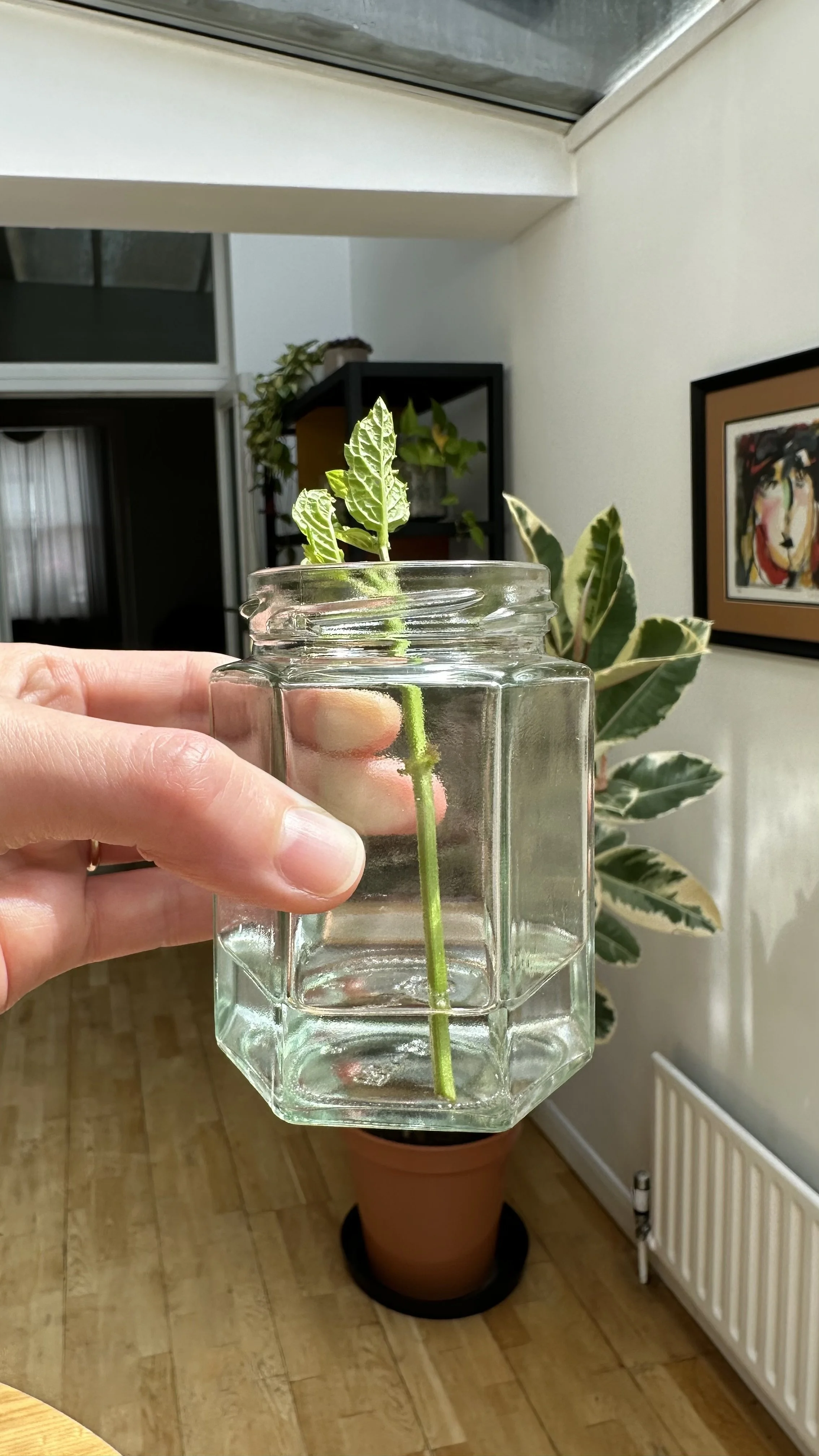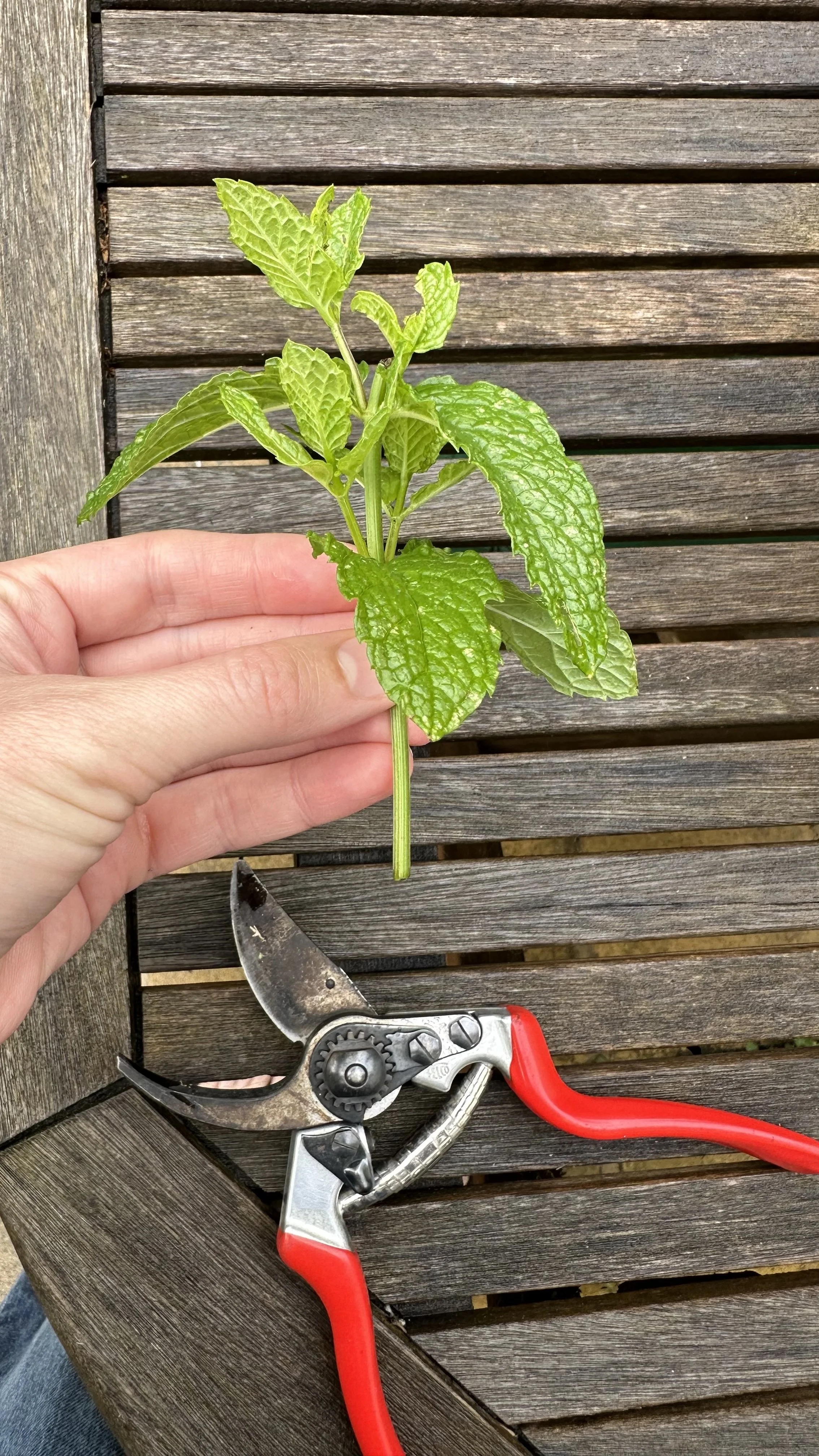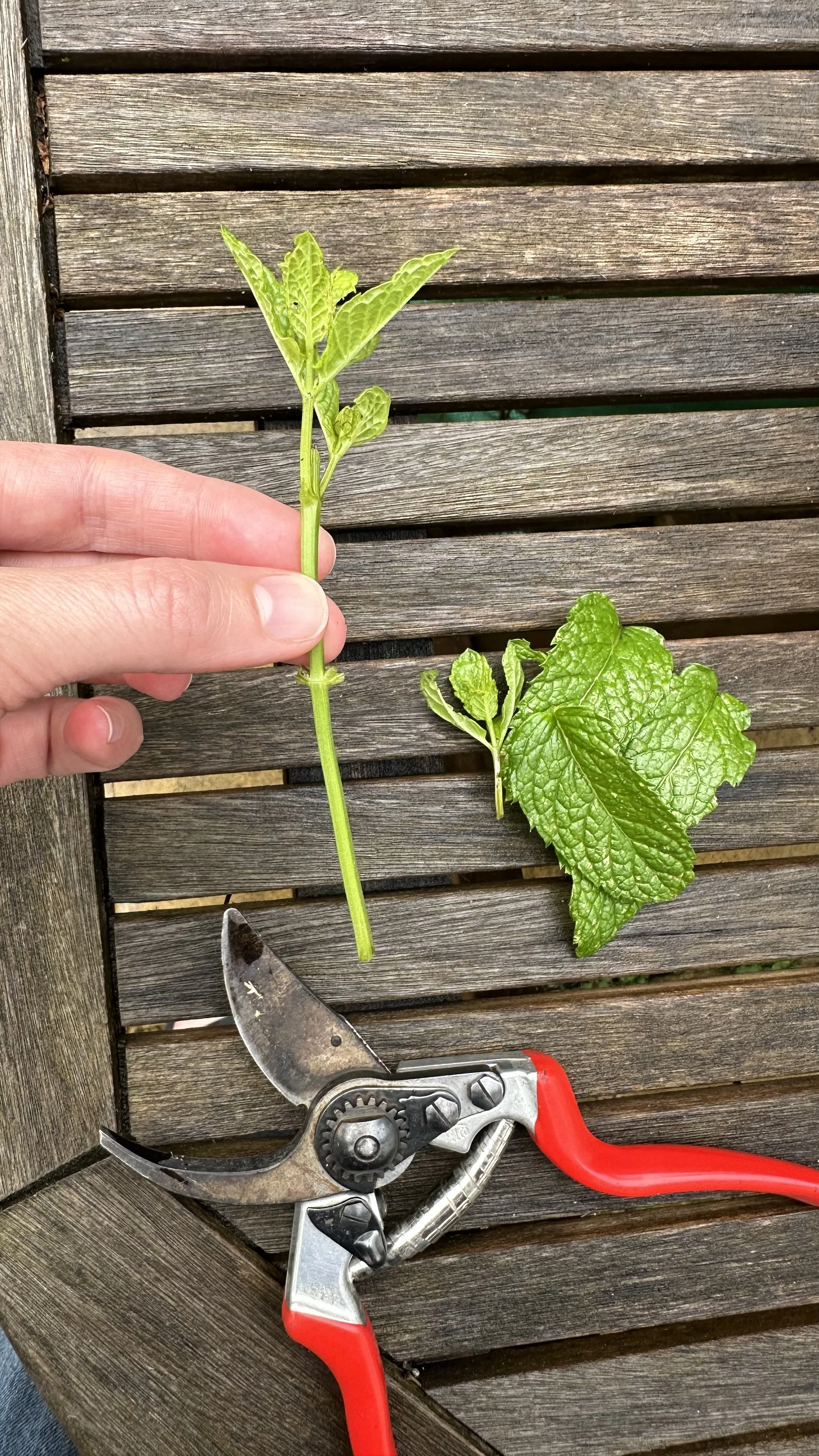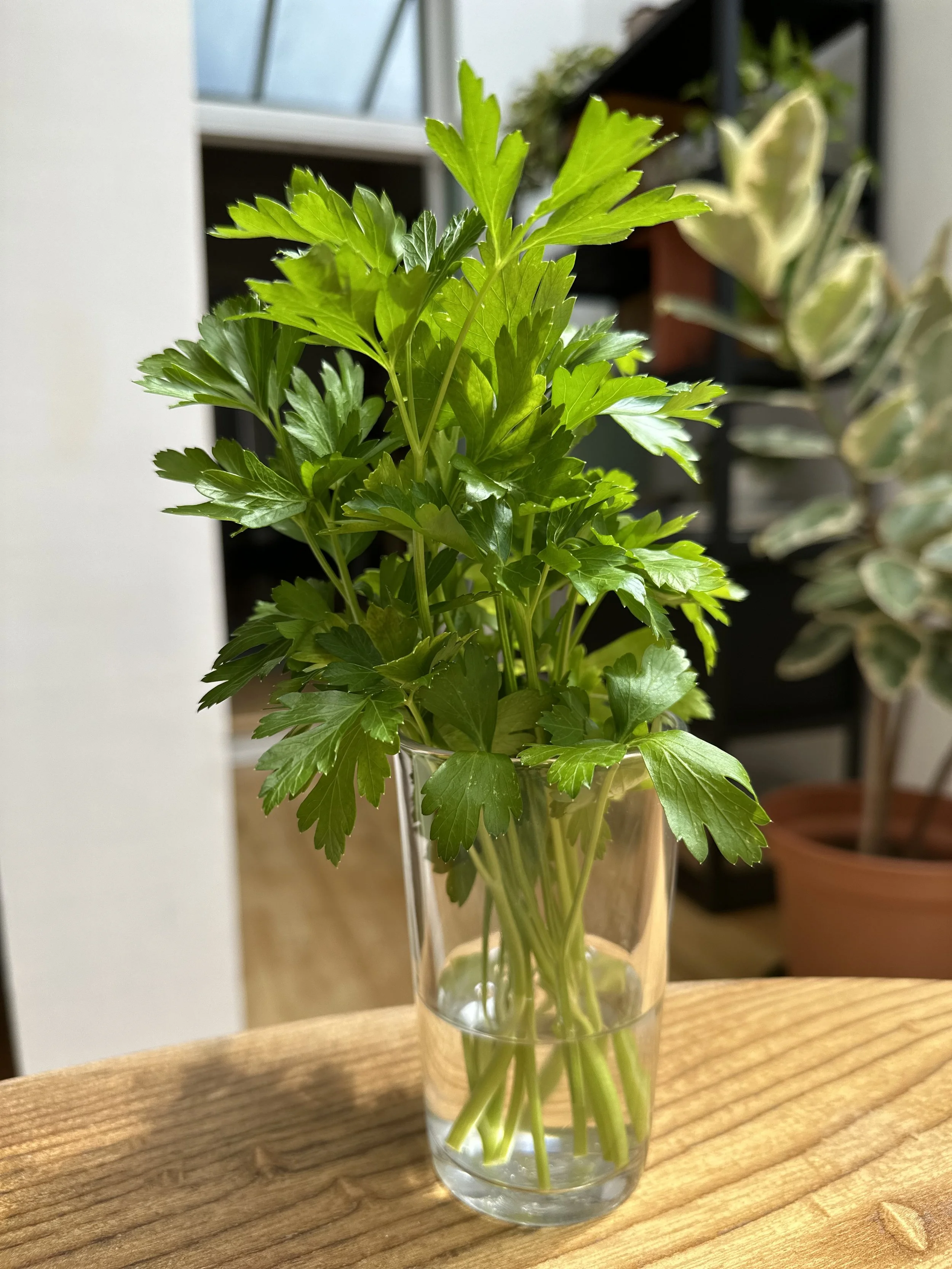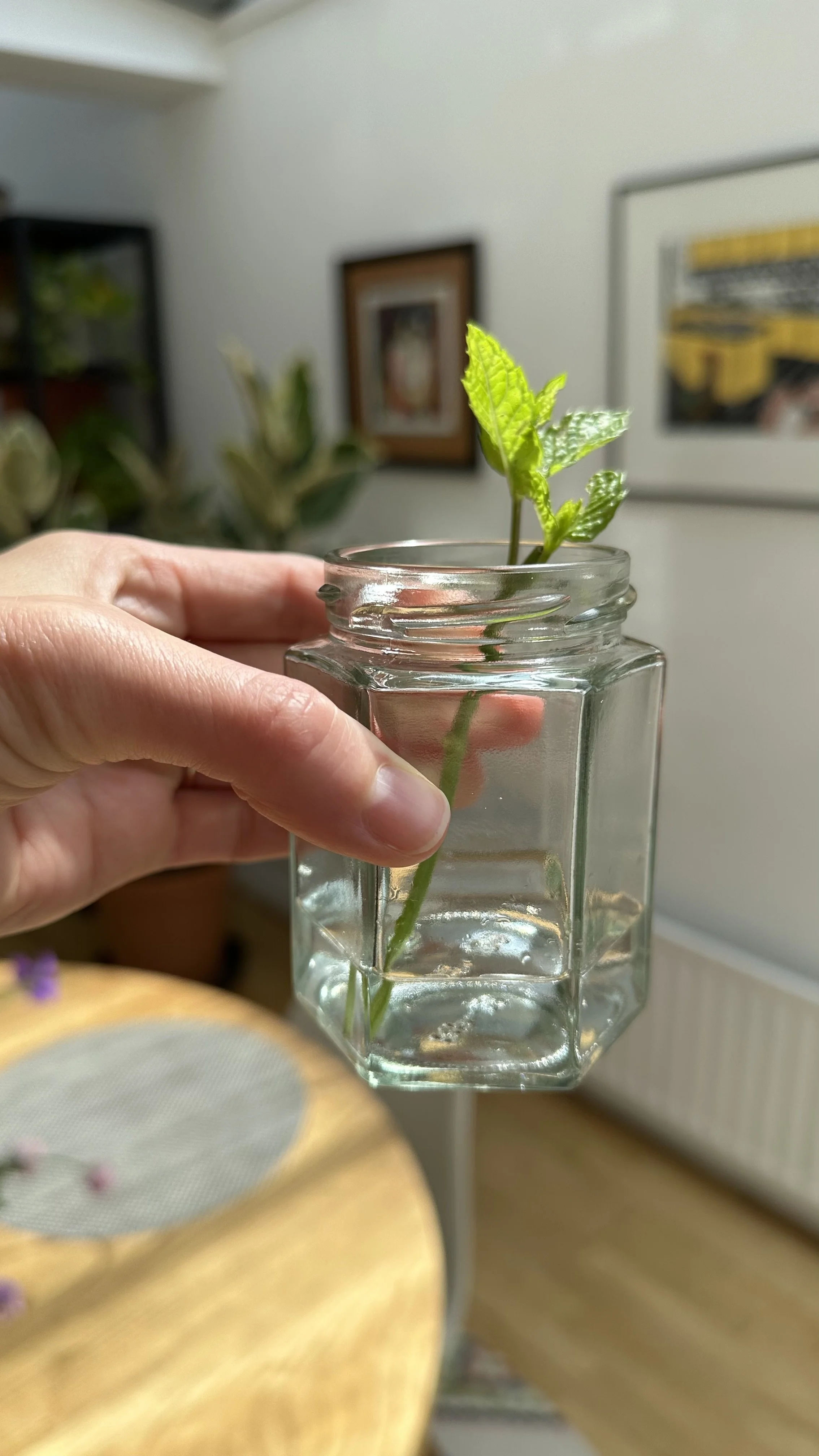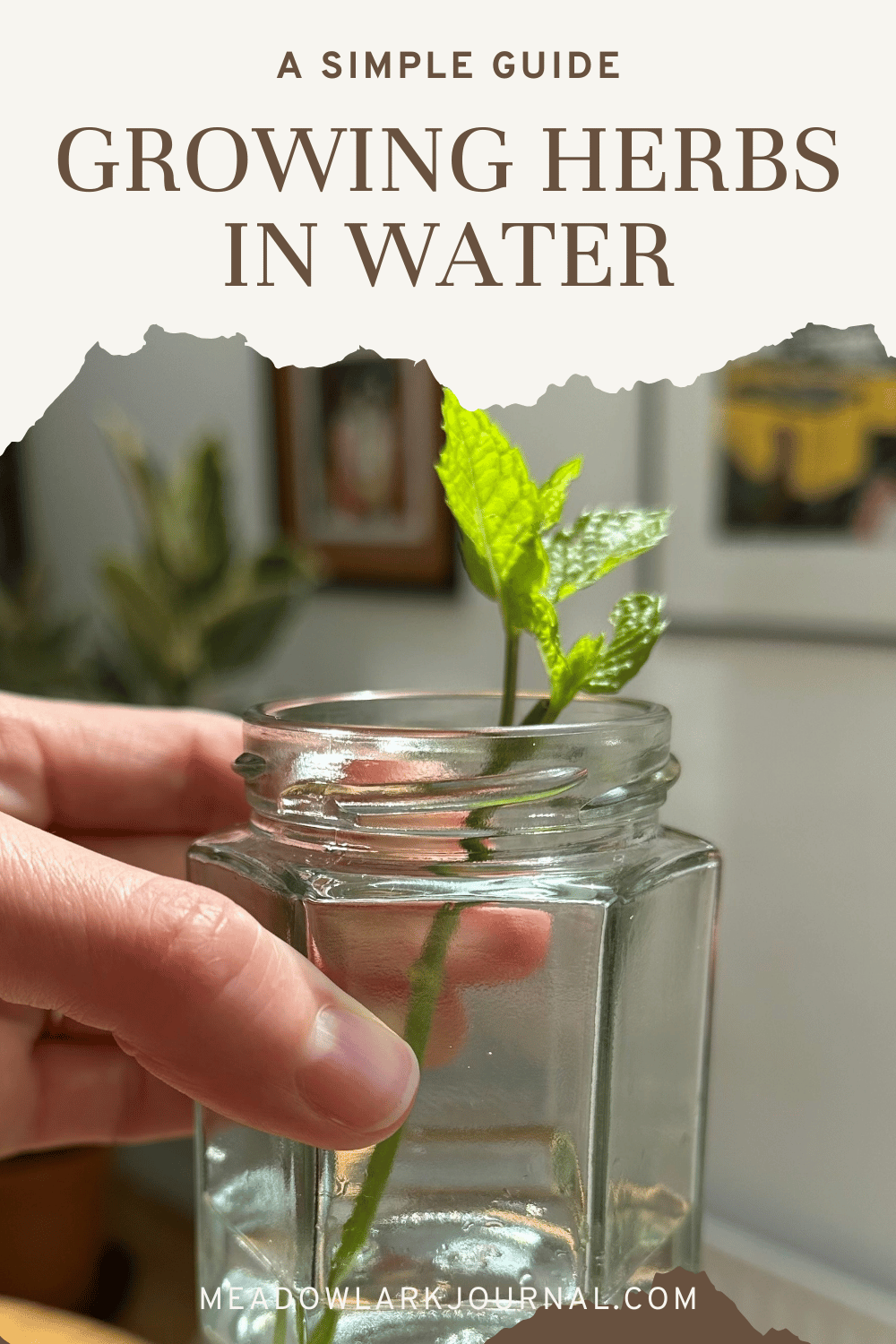Growing Herbs in Water: A Simple Guide
This website is reader-supported - thank you! This post may contain affiliate links. As an Amazon Associate, I earn from qualifying purchases at no extra cost to you.
Growing herbs in water is an excellent way to enjoy fresh herbs indoors, even if you don't have outdoor space for a traditional garden.
This method is perfect for anyone looking to have a constant supply of fresh herbs for cooking or simply to brighten up their kitchen with a mini herb garden.
In this guide, we'll explore the benefits of growing herbs in water, what you'll need to get started, and step-by-step instructions to help you create your very own water-based herb garden at home.
To learn more about growing herbs, check out my guide:
Why Grow Herbs in Water?
Growing herbs in water offers numerous advantages, especially when you are low on space.
Here are some key reasons to consider growing herbs in water:
Low Maintenance
One of the biggest benefits of growing herbs in water is the minimal maintenance required.
Without soil, you avoid common issues such as pests, weeds, and soil-borne diseases.
This makes the process cleaner and less labor-intensive.
You only need to focus on keeping the water fresh and ensuring the herbs get enough light.
Year-Round Harvest
When you grow herbs in water, you can enjoy fresh herbs throughout the year, regardless of the season.
Indoor water gardens are not affected by weather conditions, allowing you to have a constant supply of herbs even in winter.
This is especially beneficial for those who live in regions with harsh climates.
Space-Saving
Growing herbs in water is perfect for those with limited space.
You don’t need a large garden or yard; a windowsill, countertop, or small table will suffice.
This method is ideal for apartment dwellers, urban gardeners, or anyone looking to maximize their indoor space efficiently.
Cost-Effective
Starting a water-based herb garden can be more cost-effective than traditional soil gardening.
You can use recycled glass jars or containers, and fresh herb cuttings from the grocery store can serve as your initial plants.
There’s no need to buy soil or expensive pots, making it a budget-friendly way to grow your herbs.
Fast Growth and Easy Propagation
Herbs grown in water often show faster growth rates compared to those in soil.
The continuous availability of water ensures that the plants don’t experience drought stress, leading to quicker new growth.
To learn more about propagation, check out my guide: How to Propagate Basil Like a Pro.
To learn more about growing herbs, check out my guides:
What You Need to Get Started
Starting a water-based herb garden is straightforward and requires only a few basic items.
Here’s a detailed list of what you’ll need to get your herb garden up and running with your favorite herbs:
Clean Glass Jars or Containers
The first thing you’ll need is a set of clean glass jars or containers.
These will serve as the homes for your herb cuttings.
Mason jars, recycled glass bottles, or any clear containers work well.
Clear glass is ideal because it allows you to monitor root development and water clarity easily.
Ensure that the containers are thoroughly cleaned to prevent any contamination that could harm your plants.
Here is the size jar I recommend using:
Fresh Herb Cuttings
Fresh herb cuttings are the starting point for your water garden.
You can take cuttings from existing plants in your garden or purchase fresh herbs from the grocery store.
Look for healthy, vibrant stems that are free from pests and diseases.
Popular herbs that grow well in water include basil, mint, oregano, and sage.
This is my favorite variety of basil to grow:
Water (Preferably Filtered)
Water is the most critical element in a water-based herb garden.
It’s best to use filtered or distilled water to avoid any chemicals or impurities that could affect the growth of your herbs.
Tap water can be used, but let it sit out for 24 hours to allow chlorine to dissipate.
Keeping the water clean and free from contaminants will promote healthy root development and overall plant health.
Optional: Rooting Hormone
While not essential, using a rooting hormone can speed up the rooting process and increase the chances of successful propagation.
Rooting hormone is available in powder, liquid, or gel form and helps stimulate root growth.
To use it, simply dip the cut end of the herb stem into the rooting hormone before placing it in the water.
This step is particularly helpful for herbs that are more challenging to root.
Here is the rooting hormone powder I recommend using:
Additional Helpful Tools
Although the essentials listed above are sufficient to start your water-based herb garden, a few additional tools can increase your chances of success:
Pruning Shears
A pair of clean, sharp scissors or pruning shears will help you take precise cuttings without damaging the plant.
Ensure they are sterilized before use to prevent any potential spread of diseases.
Here are my favorite pruning shears:
Labels or Markers
If you plan to grow multiple types of herbs, labeling your jars can help you keep track of which herbs are which.
Use waterproof labels or markers to write the names of the herbs on the jars.
Sunny Windowsill or Grow Lights
Herbs need plenty of light to thrive.
A sunny windowsill that receives 6-8 hours of sunlight per day is ideal.
If natural light is limited, consider using grow lights to provide the necessary light spectrum for your herbs to grow.
Small Pebbles or Marbles
Adding small pebbles or marbles to the bottom of your jars can help stabilize the herb cuttings and keep them upright.
This is especially useful for containers with wider openings.
To learn more about starting an herb garden, check out my guide: How to Start a Raised Bed Herb Garden.
Herbs you can grow in water
Selecting the right herbs is crucial for a successful water-based herb garden.
While many herbs can be grown in water, some are particularly well-suited for this method.
Here’s a detailed look at some of the best herbs to grow in water and what makes each one a great choice:
Basil
Basil is one of the easiest and most popular herbs to grow in water.
It thrives in a hydroponic environment and can produce abundant leaves to be used in the kitchen.
To grow basil in water, take a 4-6 inch cutting from a healthy plant, remove the lower leaves, and place the stem in water.
Basil needs plenty of sunlight, so ensure it gets at least 6-8 hours of light daily.
To learn more about growing basil, check out my guide: How to Propagate Basil Like a Pro.
Mint
Mint is another excellent herb for water propagation.
It grows rapidly and can quickly fill a jar with fresh, fragrant leaves.
Mint cuttings root easily in water.
Take a cutting, remove the bottom leaves, and place the stem in water.
Mint prefers a cooler spot with indirect sunlight.
To learn more about growing mint, check out my guide: Growing Mint from Cuttings: Easy Step-by-Step Guide.
Oregano
Oregano is a staple herb in Italian and Mediterranean cuisine.
It’s easy to grow in water and produces a steady supply of flavorful leaves.
Oregano cuttings root well in water and can be used fresh or dried for seasoning.
To propagate oregano, take a cutting from a mature plant, remove the lower leaves, and place the stem in water.
Oregano requires plenty of light, so place it in a sunny spot.
To learn more about growing oregano, check out my guide: Propagate Oregano: How to Multiply Your Herbs.
Sage
Sage is a hardy herb with a unique flavor that complements many dishes.
It grows well in water, though it might take a bit longer to root compared to other herbs.
Sage cuttings should be taken from new growth, as older woodier stems can be more challenging to propagate.
Place the cuttings in water, ensuring the leaves are above the waterline.
Sage needs bright light to thrive, so place it near a sunny window.
To learn more about growing sage, check out my guide: Propagating Sage: A Simple Guide.
Lemon Balm
Lemon balm is known for its fresh, lemony scent and is used in teas and desserts.
It is a member of the mint family and grows well in water.
Lemon balm cuttings root quickly and can produce a lush, aromatic plant.
To grow lemon balm in water, take a cutting, remove the lower leaves, and place the stem in water. It prefers bright, indirect light.
Other Herbs to Consider
While the herbs listed above are some of the best for growing in water, there are several others you might want to try:
Rosemary:
Although slower to root, rosemary can thrive in water with patience and proper care.
Thyme:
This herb can be grown in water but generally prefers soil.
If you want to try it, use fresh cuttings and change the water regularly.
To learn more about growing rosemary, check out my guide: How to Propagate Rosemary: A Step-by-Step Guide.
Parsley:
Parsley can be rooted in water, but it requires a bit more attention.
Ensure it receives adequate light and nutrients.
To learn more about growing parsley, check out my guide: Parsley's Perfect Partners: Companion Planting for Parsley.
Tips for Selecting Herb Cuttings
Healthy Plants:
Always take cuttings from healthy, disease-free plants.
Avoid plants with yellowing leaves or signs of pest damage.
Freshness:
Use fresh cuttings to ensure better rooting success.
If using store-bought herbs, choose the freshest bunches available.
Stem Length:
Opt for cuttings that are 4-6 inches long.
This length provides enough stem for rooting while supporting new growth.
Check out my guide: How to Store Dried Herbs: Tips to Ensure they Last Longer.
Step-by-Step Guide to Growing Herbs in Water
Starting a water-based herb garden is super straight-forward.
Follow these detailed steps to ensure your herbs thrive and provide a continuous supply of fresh leaves.
Step 1: Take Cuttings
Begin by selecting healthy herb plants.
Using clean scissors or pruning shears, cut a 4-6 inch stem from the plant.
Make the cut just below a node (the point where leaves attach to the stem).
This is where roots are most likely to form.
Remove the lower leaves to prevent them from rotting in the water, leaving only the top set of leaves.
Step 2: Prepare the Container
Choose a clean glass jar or container for your cuttings.
Glass jars are ideal because they allow you to see root growth and monitor water clarity.
Fill the container with filtered or distilled water, leaving about an inch of space at the top.
If you prefer, you can use tap water that has been left out for 24 hours to allow chlorine to dissipate.
Step 3: Apply Rooting Hormone (Optional)
Using a rooting hormone can speed up the rooting process and improve the success rate of your cuttings.
Dip the cut end of each stem into the rooting hormone before placing it in the water.
While this step is optional, it can be particularly helpful for herbs that are more difficult to root.
Step 4: Place in Water
Insert the prepared cuttings into the water-filled container.
Ensure that the stem is submerged while keeping the leaves above the waterline.
This prevents the leaves from rotting and keeps the plant healthy.
If you’re using a container with a wide opening, you can add small pebbles or marbles to help stabilize the cuttings and keep them upright.
Step 5: Find the Right Spot
Place your containers in a location that receives plenty of natural light.
A sunny windowsill is ideal, as most herbs need about 6-8 hours of sunlight per day.
If natural light is limited, consider using grow lights to provide the necessary light spectrum for your herbs to grow.
Adjust the position as needed to ensure your herbs get adequate light.
Step 6: Change the Water Regularly
To keep your herbs healthy, change the water every few days.
Fresh water provides essential nutrients and oxygen, preventing stagnation and the growth of harmful bacteria.
When changing the water, rinse the roots gently to remove any debris.
Ensure the new water is at room temperature to avoid shocking the plants.
Additional Tips for Success
Monitor New Growth:
Keep an eye on your cuttings for signs of new growth.
Healthy roots will start to develop within a few weeks, followed by new leaves.
This indicates that your herbs are thriving.
Use Fresh Herbs:
Fresh cuttings from the grocery store can work, but make sure they’re healthy and vibrant.
Wilted or damaged cuttings are less likely to root successfully.
Keep an Eye on Water Levels:
Always ensure the stems are submerged in water.
As water evaporates, top up the container to maintain the correct water level.
Troubleshooting Common Issues
Rotting Stems:
If the stems begin to rot, it’s usually due to submerged leaves or stagnant water.
Remove any rotting parts, change the water more frequently, and ensure leaves are above the waterline.
Lack of Root Growth:
If roots aren’t developing, make sure your cuttings are getting enough light and the water is clean.
Using a rooting hormone can also help stimulate root growth.
Tips for Success
Monitor New Growth: Look out for new leaves and roots to know your herbs are thriving.
Use Fresh Herbs: Fresh cuttings from the grocery store can work, but make sure they’re healthy.
Keep an Eye on Water Levels: Always ensure the stems are in water and adjust as needed.
For more gardening tips, check out my guide: The Best Gardening Books for Beginners.
Learn how to propagate more herbs with my guide: How to Take Lavender Cuttings: A Step-by-step Guide.
FAQs
Can I grow mint in water forever?
Yes, mint can thrive in water indefinitely if you provide it with proper care.
Here are a few tips to keep mint healthy in water:
Regular Water Changes:
Change the water every few days to prevent stagnation and the build-up of bacteria.
Adequate Light:
Place the mint in a spot with bright, indirect sunlight.
Mint can tolerate lower light conditions, but more light promotes vigorous growth.
Nutrient Supplementation:
Over time, water alone might not provide all the necessary nutrients.
You can occasionally add a small amount of liquid fertilizer to the water to ensure your mint receives adequate nutrition.
Can you grow basil in water?
Absolutely! Basil is one of the easiest herbs to grow in water.
Basil will start to develop roots within a few weeks, and you'll have a continuous supply of fresh leaves.
How much water does thyme need?
While thyme can be grown in water, it generally prefers soil. If you choose to grow thyme in water:
Regular Water Changes: Change the water every few days to keep it oxygenated and fresh.
Submerge Stems: Ensure the stems are always submerged while the leaves remain above water.
Adequate Light: Place thyme in a spot with plenty of sunlight.
Growing thyme in water requires frequent attention to water quality and light, making it more challenging than other herbs.
Can you root parsley in water?
Yes, parsley can be rooted in water.
Parsley may take a bit longer to root compared to other herbs, so patience is key.
What are the fastest-growing indoor herbs?
Some of the fastest-growing indoor herbs include:
Basil: Quick to root and grow, providing a constant supply of leaves.
Mint: Rapid growth and easy propagation in water.
Oregano: Fast-growing and perfect for a variety of dishes.
Chives: Grow quickly and are great for garnishing and adding flavor.
Lemon Balm: Grows robustly indoors and has a refreshing scent.
Pin this post to save it for later!
